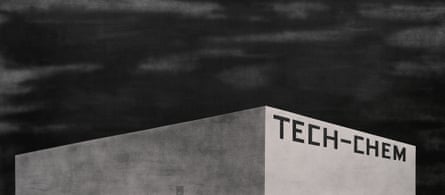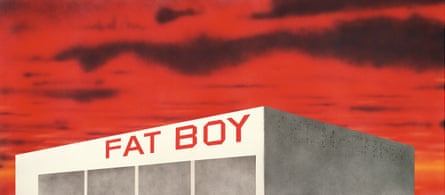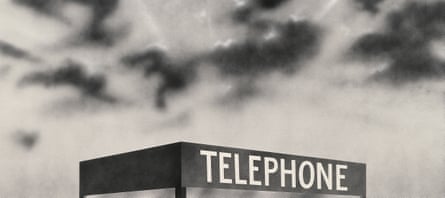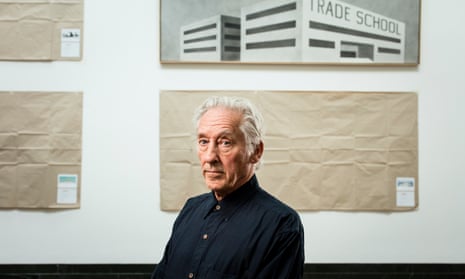Shortly after meeting Ed Ruscha, in an office space deep within the bowels of the National Gallery, we’re confronted by a terrifying vision. It’s Donald Trump. And he’s naked.
“Oh boy,” mutters the man JG Ballard once claimed had the “coolest gaze in American art”. He averts said gaze from the image in question – a book illustrated with Illma Gore’s grotesque depiction of the president, complete with fleshy rolls and tiny stubby penis – and shakes his head. “I think the art world’s still in shock by it, we’ve not had time to react yet,” he says. “We’re all sitting in an electric chair.” He grabs the sides of his seat and mimics a rush of high voltage, before laughing.
Of course, you could argue that Ruscha commented on the Trump presidency back before Trump was even thinking of running for president. His Course of Empire series, which opens on Monday at the National Gallery, might not be directly about Trump or even politics (“That word can mean anything so I tend to dance away from it,” he notes). But it’s hard to view its depiction of the turbo-speed transformation of the modern United States without seeing it as a warning sign.
The exhibition hangs Ruscha’s 1992 series Blue Collar – five black-and-white canvases featuring buildings in LA – above updated versions he made a decade or so later, this time in colour and with each location radically changed. The trade school is now surrounded by a barbed wire fence. The phone booth no longer has a reason to exist, so it doesn’t. The tool and die factory is now emblazoned with Korean-style calligraphy (Ruscha invented the meaningless typeface himself, speaking to global companies’ lack of transparency – what do they even do?). Logos have faded, fences corroded, and graffiti has sprung up. It’s the kind of transformation that has left many Americans feeling adrift. And it at least partly explains why so many chose to elect a president who claimed he could bring the old America back.

It’s a viewpoint that Ruscha can relate to. “On the one hand we’re supposed to embrace new ideas and aggression, or at least the positive side of aggression,” he says. “But I don’t want to see the old world go away. I like the black and white world. I equate my growing up and first coming to LA [with the] black and white world. But now we’ve got Vegas everywhere. I saw it just now at Piccadilly Circus … these giant motion graphics. Soon it will be everywhere – in small towns in America and probably England, too, with people using their real estate as possibilities for advertising. It’s scary, but it’s coming soon.”
That phrase could sum up the foreboding that lurks in Ruscha’s work, zen visions of the modern American west infused with a sense of impending apocalypse. Now 80, he’s a little unsteady on his feet but sharp as a tack. His photography and paintings have helped define modern America – its gas stations, corporate logos and prairies. But there’s often an unsettling undertow – as in his most famous work, The Los Angeles County Museum on Fire.
Ruscha’s word paintings, in which pithy phrases are afforded the same towering scale as mountain ranges, can be many things: enigmatic, playful and sometimes seemingly plain dumb. But often they unnerve – Pay Nothing Until April; The Music From the Balconies Nearby Was Overlaid by the Noise of Sporadic Acts of Violence. One series focuses on the simple phrase The End. Are we approaching it?

Ruscha, pronounced roo-SHAY, was born in Nebraska, but grew up in Oklahoma. It took an On the Road-style drive to Los Angeles with his friend, the writer and musician Mason Williams, to awaken his artistic instinct. Over that 1,400-mile trip, in a car that used “as much oil as it did gasoline”, Ruscha found himself mesmerised by the utilitarian beauty of the remote gas stations dotted along the open landscape – he’d later produce his first artist’s book, 1963’s Twentysix Gasoline Stations, and his iconic Standard Station variations.
While the gravitational pull of New York’s art scene was overwhelming, Ruscha’s individualist streak nudged him towards LA. His preferred school, Artcenter, didn’t have a place for him, a setback that proved to be fortuitous. Artcenter had a strict dress code – “no facial hair, berets or bringing a bongo to class” – whereas Chouinard Art Institute, where he ended up, let students do “whatever you want”. Had he got into his favoured college, Ruscha may not have become one of America’s most renowned artists. “I might be designing the rear wheel of a Toyota instead,” he says. “Who knows?”
Ruscha never considered art as a viable career and kept himself afloat painting signs and designing books. An early break came when he was included in the landmark 1962 pop art exhibition New Painting of Common Objects at the Pasadena Art Museum, alongside Roy Lichtenstein and Andy Warhol. Ruscha knew Warhol: “They made fun of him, but he really saw the light ... a very pure light and he was able to grab it. His movies should be considered in the all-time pantheon of movie-making, but people in Hollywood would just say, ‘This guy’s a fake’ or ‘He’s putting us on.’ Maybe he was, but I found his ideas very profound.”
One of Ruscha’s first sales was to Dennis Hopper, and the pair became friends. Did he encounter the actor’s dark side? “He had drug problems and explosive moments – none that I had to fully experience in the raw. I knew that he had periods of depression and he had lady problems” – he smiles at this euphemism. “He also had problems with a lot of people because he had ideas that he thought should be run his way. And I’m all for that.”

At the National, Ruscha’s Course of Empire is displayed concurrently with the series that inspired it – Thomas Cole’s The Course of Empire, which depicts the rise and fall of a civilisation across five canvases. Although vastly different works, the two artists share many similarities. Both can be said to have reinvented the American landscape tradition (Cole was born in Bolton, Lancashire, in 1801, but moved to the States); both are obsessed with the passage of time, and both can be said to instil portent within their works.
“His was driven purely by a hatred of the progress of mankind, clear-cutting forests, things we’ve all lived through for many years since his death,” says Ruscha. “If you were to go back, find the place that he set up his canvas for The Oxbow” – Cole’s 1836 masterpiece that warned of the folly of cultivating land – “then you’d be greatly shocked. I see all kinds of trouble in the world, but I think he would weep at the poetry of change.”
If Cole issued alarms about the burgeoning expansion of the American empire, Ruscha’s work, which documented its glitzy Hollywood peak, now seems to be warning us that it’s concluding. Does he think it is? “It’s a knock on the door, isn’t it? It’s a tender reminder that we might be at the end of our Rome.”

The hectic pace of change is equally apparent when looking at the art world’s transformation. Ruscha started out painting for “sport” – money didn’t enter into the equation. Now his paintings can fetch tens of million dollars. He seems bemused by this change of fortunes, although his faith in the quality of his work remains solid. “I’ve done things that I’ve felt were kissed by angels,” he says. “I’ve tried to open the gates of heaven, as all artists hope to. Whether we do or not is another matter.”
I wonder how he views his influence – especially in mainstream pop culture where word art is everywhere, from memes to inspirational gift cards. On the day we meet, Kanye West has just released his album Ye, featuring a sleeve of the Wyoming mountains with the text “I hate being bipolar it’s awesome” scrawled over it. “Oh boy,” says Ruscha, reading the words aloud to himself. Does he see his influence in juxtapositions like this?
“I think that could have come from anywhere,” he says, politely declining any connection. “All art comes out of other art, but I don’t see my influence that widely.”
Is he disappointed by that?
“Not at all. As a matter of fact, it kind of isolates me in a nice way.”
Isolation suits Ruscha. He built a home in the Mojave desert several decades ago and still returns there when he needs space. “The constant reminder that there is very little change, even over 40 or 50 years, invigorates me,” he says. It also reassures him when faced with his many fears about modern life – the rise of robotics, the mining of our data, the blurring of truths. The accelerated culture he’s documented so perfectly is starting to leave him in the dust, he admits.
“I come across people every so often who think, God, he doesn’t have an iPhone, that’s disgusting! He’s no patriot!” he says, laughing heartily. “But I didn’t have an interest in the internet and I still don’t. The way I look at it is – it’s too late to learn.”
Looking at Course of Empire, you wonder if that’s true of all of us.

Comments (…)
Sign in or create your Guardian account to join the discussion